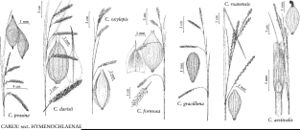Carex formosa
Amer. J. Sci. Arts 8: 98. 1824.
Plants densely cespitose. Culms dark maroon at base; flowering stems 0.5–1 mm thick, 30–80 cm, longer than leaves at maturity, glabrous but scabrous on angles within inflorescence. Leaves: basal sheaths maroon, bladeless, pubescent, sometimes glabrous, others grading from marooon to green on back, white-hyaline, red dotted, and pilose on front; blades flat, 3–7 mm wide, glabrous on adaxial surface, pilose on abaxial surface and margins. Inflorescences: ; peduncles of lateral spikes slender, to 10 cm, usually much longer than spikes, pubescent; of terminal spikes 25–50 mm, pubescent; proximal bracts nearly equaling but usually not exceeding inflorescences; sheaths 35–85 mm; blades 2.5–4.5 mm wide. Lateral spikes 2–4, 1 per node, well separated, drooping at maturity, pistillate except for 1 or 2 basal staminate flowers in each, with 8–25 perigynia per spike attached 1 mm apart, cylindric, 15–25 × 4–6 mm. Terminal spike gynecandrous, 15–30 × 5–6 mm in distal pistillate portion, 1.5–2 mm wide in proximal staminate portion. Pistillate scales pale hyaline tinged with chestnut brown, broad green midrib red dotted, ovate, shorter than mature perigynia, apex acute to cuspidate, awn less than 1 mm, glabrous. Perigynia green, copiously red dotted, 2-ribbed with 7–12 fine veins on each face, loosely enveloping achene, ovoid-ellipsoid, 3.5–5 × 1.7–2 mm, membranous, base with short stipe, apex narrowing to abrupt beak, glabrous; beak minutely bidentate, less than 0.5 mm. Achenes substipitate, 2–2.5 × 1.4–1.5 mm.
Phenology: Fruiting early–mid summer.
Habitat: Mesic to dry deciduous forests and ravines, moist meadows, usually associated with calcareous soils
Distribution

Ont., Que., Conn., Ill., Iowa, Mass., Mich., Minn., N.Y., N.Dak., Ohio, Vt., Wis.
Discussion
Carex formosa appears to be confined to areas with calcareous soils making it uncommon and sparsely distributed throughout its range, although some populations are quite large.
Selected References
None.
